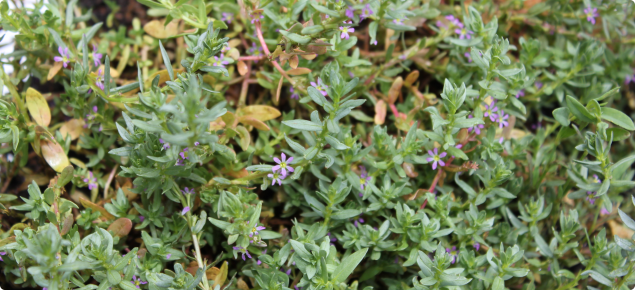Why is it a problem?
Wetter seasonal conditions will favour the plant’s growth and it is able to grow rapidly. It is an upright, hard stemmed plant similar to rosemary that grows to 40cm in height and has tiny pink flowers. Closer to the coast it grows slightly softer and less upright.
Recommendations
- Remove sheep from paddocks where it is present.
- Affected sheep should be fed good quality hay and a low protein supplement such as oats, or other cereal grains, during recovery. This will need to be fed for a couple of weeks before re-introduction to higher protein feeds.
- A supply of fresh water is important as stock have compromised kidney function.
- Provide shade to reduce the risk of photosensitisation.
- Take care of other health requirements: Where sheep are stressed by disease or nutrition, worm burdens can build rapidly. Flocks need to be monitored for the presence of high worm burdens. Drenching decisions should be based on worm egg counts. Where sheep are clinically sick drenching may be better delayed until some recovery has occurred.
- Profoundly unwell sheep that are unlikely to recover should be euthanased.
Following removal of stock from grazing the plant, stock losses should abate after about four days. Depending on the dose consumed and amount of organ damage some losses may continue for up to two months. Stock owners need also to be wary of other potential causes of illness at this time.
Control of the plant
Controlling the hyssop loosestrife plant now is recommended for two reasons. Firstly to prevent a seed bank setting for future years and secondly there are no known losses in stock on dead plant material. It is not known whether killing the plant makes it unpalatable to stock or reduces the toxicity however past experience indicates dead hyssop loosestrife plant is safer than the green plant.
Herbicides registered in Australia for control of young hyssop loosestrife include diflufenican (for example, Brodal®), diflufenican + MCPA (for example, Tigrex®) and mixtures of terbutryn + triasulfuron.
Mature hyssop loosestrife is expected to tolerate normal rates of many common herbicides. Glyphosate plus triclopyr appears to provide the most cost effective control on similar plants overseas. However they may also make the plant more palatable and thus increase the risk of poisoning while the plant is dying. Desiccant herbicides such as paraquat are expected to be more effective than slashing where grazing of the paddock is required. If you are returning stock into paddocks with dead plant material graze with caution.
If stock will not be grazing the infested paddock, 2L/ha glyphosate 450 or a glyphosate plus triclopyr mix such as 2L glyphosate plus 500mL triclopyr 600 per hectare (for example, Garlon®) is the most economical control around $10-15/ha for chemical.
For paddocks that have to be grazed, 2L/ha of paraquat (or Spray.Seed®) plus 250g/ha atrazine 900 plus 1Lof spray oil per 100L of spray mix is expected to provide good control. This will give rapid death of the plant within a few days and make it less palatable. However, there may be regrowth and a second spray may be required in some situations. The withholding period for grazing varies between the various products and graziers should check the label to find an appropriate product for their situation.

